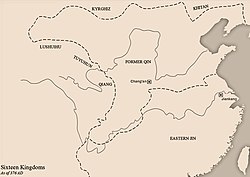Former Qin
Former Qin 秦 | |||||||||||||||||||
|---|---|---|---|---|---|---|---|---|---|---|---|---|---|---|---|---|---|---|---|
| 351–394 | |||||||||||||||||||
 Former Qin 376 CE | |||||||||||||||||||
 | |||||||||||||||||||
| Capital | Chang'an (351-385) Jinyang (385-386) Nan'an (386-394) Huangzhong (394) | ||||||||||||||||||
| Government | Monarchy | ||||||||||||||||||
| Emperor | |||||||||||||||||||
• 351-355 | Fu Jian (317–355) | ||||||||||||||||||
• 355-357 | Fu Sheng | ||||||||||||||||||
• 357-385 | Fu Jian (337–385) | ||||||||||||||||||
• 385-386 | Fu Pi | ||||||||||||||||||
• 386-394 | Fu Deng | ||||||||||||||||||
• 394 | Fu Chong | ||||||||||||||||||
| History | |||||||||||||||||||
• Fu Jian (317–355)'s entry into Chang'an | 350 | ||||||||||||||||||
• Established | 4 March[1][2] 351 | ||||||||||||||||||
• Fu Jian (317–355)'s claim of imperial title | 352 | ||||||||||||||||||
• Fu Jian (337–385)'s destruction of Former Yan | 370 | ||||||||||||||||||
| 383 | |||||||||||||||||||
• Fu Jian (337–385)'s death | 16 October 385[3][4] | ||||||||||||||||||
• Disestablished | 394 | ||||||||||||||||||
• Fu Hong's death | 405 | ||||||||||||||||||
| |||||||||||||||||||
| Today part of | China Vietnam Laos Mongolia | ||||||||||||||||||
| Former Qin | |||||||
|---|---|---|---|---|---|---|---|
| Chinese | 前秦 | ||||||
| |||||||
The Former Qin (351-394) was a state of the Sixteen Kingdoms in eastern Asia, mainly China. Founded by the ethnic Di officer Fu Jian (317–355) of Shi Le's dynasty, it completed the unification of North China in 376.[5] Its capital was Xi'an up to the death of the ruler Fu Jian (337–385) in 385. Despite its name, the Former Qin was much later and less powerful than the Qin Dynasty which had ruled all of China during the 3rd century BC. The adjective "former" is used to distinguish it from the "Later Qin" state (384-417).
The severe defeat of the Former Qin in the Battle of Fei River in 383 encouraged uprisings, which split the Former Qin territory into two noncontiguous pieces after the death of Fu Jian. One fragment, at present-day Taiyuan, Shanxi was soon overwhelmed in 386 by the Xianbei under the Later Yan and the Dingling. The other struggled in greatly reduced territories around the border of present-day Shaanxi and Gansu until disintegration in 394 following years of invasions by Western Qin and Later Qin.
In 327, the Gaochang commandery was created by the Former Liang under the Han Chinese ruler Zhang Gui. After this, significant Han Chinese settlement occurred, meaning that a major part of the population becoming Chinese. In 383, the General Lu Guang of Former Qin seized control of the region.[6]
All rulers of Former Qin proclaimed themselves "Emperor", except for Fu Jian (苻堅) (357–385) who instead claimed the title "Heavenly King" (Tian Wang). He was nonetheless posthumously considered an emperor.
Rulers of the Former Qin
| Temple name | Posthumous name | Personal name | Durations of reigns | Era names |
|---|---|---|---|---|
| Gaozu | Jingming | Fu Jian (苻健) | 351-355 | Huangshi (皇始) 351-355 |
| – | King Li¹ | Fu Sheng | 355-357 | Shouguang (壽光) 355-357 |
| Shizu | Xuanzhao | Fu Jian (苻堅) | 357-385 | Yongxing (永興) 357-359 Ganlu (甘露) 359-364 |
| – | Aiping | Fu Pi | 385-386 | Taian (太安) 385-386 |
| Taizong | Gao | Fu Deng | 386-394 | Taichu (太初) 386-394 |
| – | – | Fu Chong | several months in 394 | Yanchu (延初) 394 |
¹ Fu Sheng was posthumously given the title "wang" even though he had reigned as emperor.
Rulers family tree
| Former Qin | |||||||||||||||||||||||||||||||||||||||||||||||||||||||||||||||||||||||||||||||||||||||||||||||||||||||||||||||||||||||||||||||||||||||||||||||||||||||||||||||||||||||||||||||||||||||||||||||
|---|---|---|---|---|---|---|---|---|---|---|---|---|---|---|---|---|---|---|---|---|---|---|---|---|---|---|---|---|---|---|---|---|---|---|---|---|---|---|---|---|---|---|---|---|---|---|---|---|---|---|---|---|---|---|---|---|---|---|---|---|---|---|---|---|---|---|---|---|---|---|---|---|---|---|---|---|---|---|---|---|---|---|---|---|---|---|---|---|---|---|---|---|---|---|---|---|---|---|---|---|---|---|---|---|---|---|---|---|---|---|---|---|---|---|---|---|---|---|---|---|---|---|---|---|---|---|---|---|---|---|---|---|---|---|---|---|---|---|---|---|---|---|---|---|---|---|---|---|---|---|---|---|---|---|---|---|---|---|---|---|---|---|---|---|---|---|---|---|---|---|---|---|---|---|---|---|---|---|---|---|---|---|---|---|---|---|---|---|---|---|---|
| |||||||||||||||||||||||||||||||||||||||||||||||||||||||||||||||||||||||||||||||||||||||||||||||||||||||||||||||||||||||||||||||||||||||||||||||||||||||||||||||||||||||||||||||||||||||||||||||
See also
Notes and references
- ^ http://www.sinica.edu.tw/ftms-bin/kiwi1/luso.sh?lstype=2&dyna=%AAF%AE%CA&king=%BFp%AB%D2&reign=%A5%C3%A9M&yy=7&ycanzi=&mm=1&dd=&dcanzi=%A4%FE%A8%B0
- ^ Zizhi Tongjian, vol. 99.
- ^ http://www.sinica.edu.tw/ftms-bin/kiwi1/luso.sh?lstype=2&dyna=%AAF%AE%CA&king=%A7%B5%AAZ%AB%D2&reign=%A4%D3%A4%B8&yy=10&ycanzi=&mm=8&dd=&dcanzi=%A8%AF%A4%A1
- ^ Zizhi Tongjian, vol. 106.
- ^ Grousset, Rene (1970). The Empire of the Steppes. Rutgers University Press. pp. 58–59. ISBN 0-8135-1304-9.
- ^ Society for the Study of Chinese Religions (U.S.), Indiana University, Bloomington. East Asian Studies Center (2002). Journal of Chinese religions, Issues 30-31. the University of California: Society for the Study of Chinese Religions. p. 24. Retrieved 17 May 2011.
{{cite book}}: CS1 maint: multiple names: authors list (link)
Society for the Study of Chinese Religions (U.S.), Indiana University, Bloomington. East Asian Studies Center (2002). Journal of Chinese religions, Issues 30-31. the University of California: Society for the Study of Chinese Religions. p. 24. Retrieved 17 May 2011.{{cite book}}: CS1 maint: multiple names: authors list (link)
